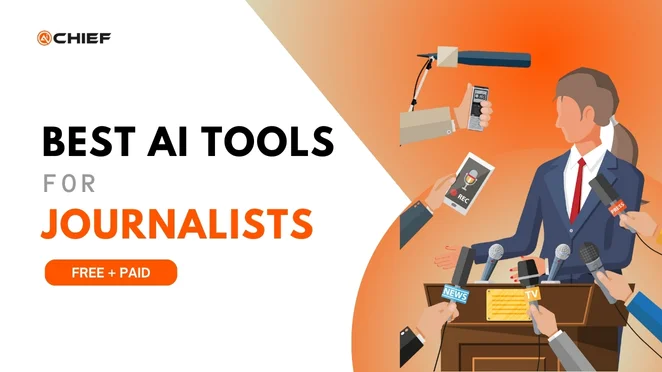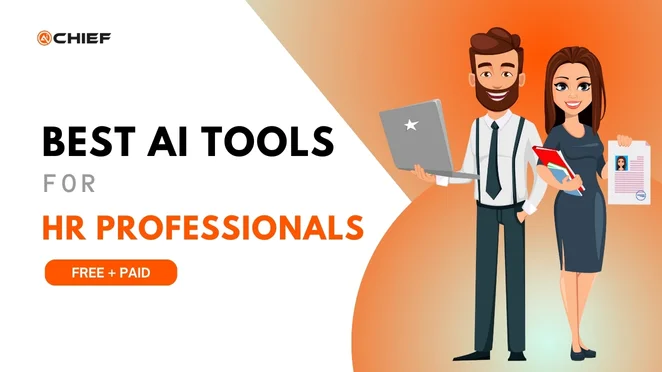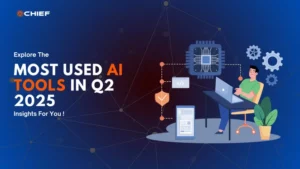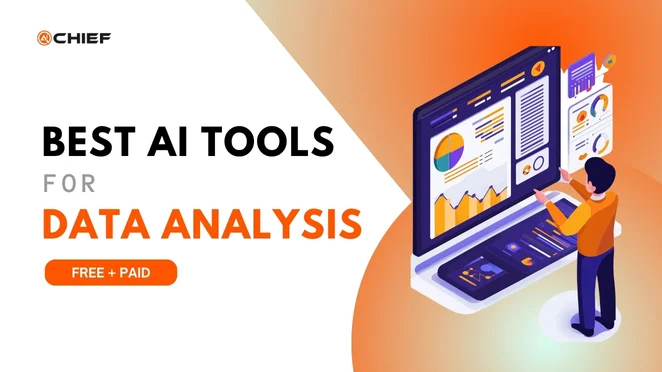
AI tools have revolutionized every aspect of your business, and when we’re talking about businesses, how can we miss AI tools for data analysis? These incredible tools have upscaled the trends of making informed decisions.
In this detailed guide, we’ll cover some important features, pricing, and much more to help you choose the right tool for extracting meaningful insights from your data.
Table of Contents
What are AI tools for data analysis?
AI data analytics refers to tools that use advanced AI technologies to analyze large data sets and gain valuable insights. These insights further help the user scale the trends and uncover insights for data analysts.
In addition to that, these tools analyze large data files to enhance the process of decision-making and free up time for strategic tasks. These tools have revolutionized the predictive capabilities of businesses with their intuitive interface.
Top 10 AI-Powered Data Analysis Tools
In this section, the editors of AIChief have listed amazing tools that will help you extract meanings from vast data sets. Let’s have a look at these tools:
1. KNIME

Data analysis is no longer a niche-based skill. AI tools have transformed this with tools like KNIME. This platform is open-source and helps the user to use data science and connect to various data sources.
Furthermore, it can be used by anyone regardless of their programming skills. This AI data analyst helps you blend and analyze resource-intensive and large data sets easily. You can gain insights with deployment and monitoring features.
Key Features
Here are the key features of Knime:
- Visual Workflows
- Data Access and Integration
- Advanced Analytics
- Machine Learning
- Generative AI Integration
- AI Assistant (K-AI)
- Deployment and Monitoring
Pros and Cons
Pros
- It can be used by anyone because of its intuitive interface.
- KNIME can be easily accessed to meet project needs.
- This platform lets you improve efficiency and reduce errors.
Cons
- The advanced features require technical knowledge.
- Sometimes, handling large amounts of data can be challenging.
Pricing
KNIME offers a free plan along with paid plans starting from $99 per month.
2. Powerdrill AI
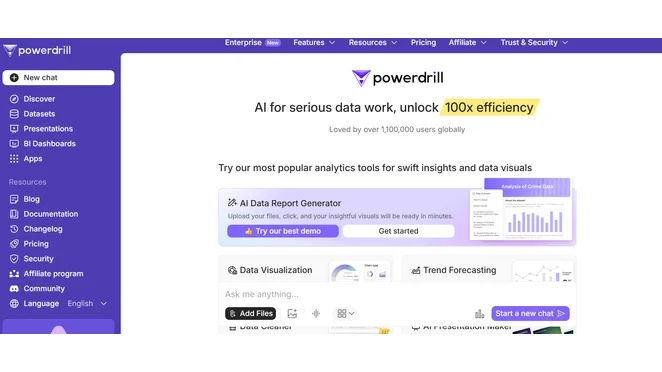
In today’s fast-paced era, finding the best platform to fit your organizational needs of data handling is complex, but Powerdrill AI has got your back. It is an extensive platform that helps you manage data with advanced visualization features.
Moreover, there are tools like AI word assistance, summarizer, and more that help you provide briefs of your data. There are various file formats available for exporting this data, such as XLSX, XLS, TSV, and CSV.
Key Features
Let’s explore some of the exceptional features of Powerdrill AI:
- Natural Language Processing (NLP)
- Data Visualization
- Data Cleaning and Preparation
- Integration with SQL Databases
- OpenAI Ecosystem Integration
- User-Friendly Interface
- Scalability
- Customization Collaboration
Pros and Cons
Pros
- It has a user-friendly interface that helps you save time.
- The error rate of this platform is very low.
- Powerdrill AI offers simple yet accurate databases for seamless collaboration.
Cons
- The output is dependent on the quality of the provided data.
- Customization options of this platform are limited.
Pricing
Powerdrill offers a free plan for the ease of its users, along with paid plans starting from $3.90/ month.
3. Tableau
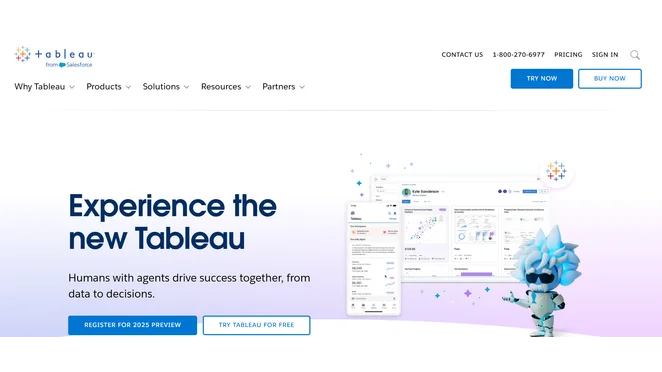
From data chaos to driving success in the business, Tableau can do it all. It is an innovative platform that helps the user by providing visual analytics to see and understand the data with ease.
Furthermore, this platform offers cutting-edge features to organize and transform data into actionable insights and facilitate data-driven decision-making. Tableau is a cloud-based platform that can scale analytics without the need to hire professionals.
Key Features
Let’s have a look at the extraordinary features of Tableau:
- Visual Analytics
- Data Integration
- AI-Powered Insights
- Collaboration and Sharing
Pros and Cons
Pros
- The simple drag-and-drop functionality makes it easy for everyone to use.
- A range of data integration options is available.
- It provides advanced analytics to identify patterns and trends.
Cons
- Customization options are limited on this platform.
- The pricing plan could be a limitation for some users.
Pricing
Data analysts can try it for free and then upgrade to paid subscription options starting from 35$ per month.
4. Sisence
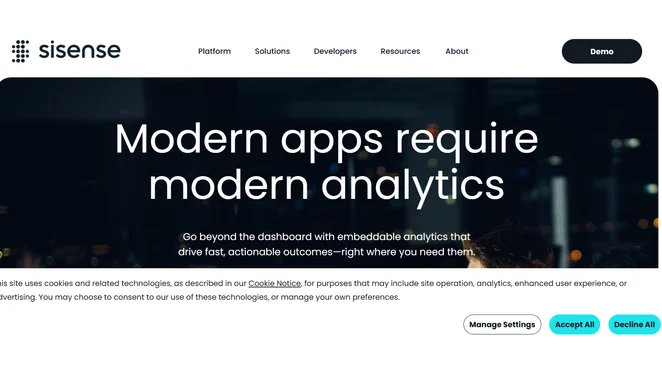
What if you could turn your raw data into valuable insights? Yes, now you can do that with the use of Sisence. This transforming platform provides actionable insights with ease. Another amazing feature of this platform is that it provides data designer courses.
Furthermore, it acts as a bridge between insights and action. Sisence lets you extract insights in minutes, which traditionally takes months. It also offers an integrated analytics experience so that APIs and SDKs are easily customized.
Key Features
Below are some key features of Sisence:
- Data Integration
- Customizable Dashboards
- AI and Machine Learning Capabilities
- Embedded Analytics
- Scalability
Pros and Cons
Pros
- It has a user-friendly interface that makes it accessible to users with varying expertise.
- Sisence is a cloud-based platform that offers flexible deployment options.
- You can access in-depth analysis and make strategic decisions.
Cons
- It is not a scalable platform for handling huge datasets.
- Users of this platform might require time and training.
Pricing
You can book a free demo or fill out a form available on their website to make a customized plan for your business.
5. IBM Watson Analytics
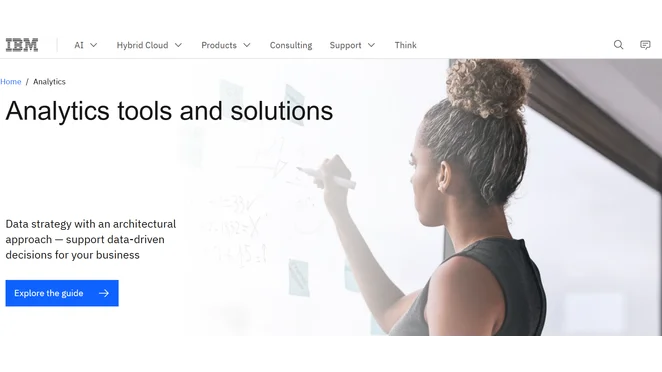
Data is an advanced form of currency; to keep up with that, IBM Analytics offers a range of tools to help you collect, organize, and analyze the data. This then helps in making data-driven decisions. It provides real-time insights and helps businesses in driving outcomes with key metrics.
Moreover, you can simplify the raw and unstructured data and receive insights in seconds. It acts like an AI-powered analyst and advisor and focuses on creating value.
Key Features
Some of the brilliant features of this platform are listed below:
- Business Analytics Software
- Data Science and Analytics
- Text Analytics
- Data Fabric Architecture
- AI-Powered Business Intelligence Assistant
Pros and Cons
Pros
- It offers a wide range of analytics tools for diverse business needs.
- IBM Analytics seamlessly integrates into existing data sources and tools.
- This platform is user-friendly and can be used by anyone regardless of their technical expertise.
Cons
- No free plan is mentioned, so it could be costly for some businesses.
- It requires a stable internet connection for proper functioning.
Pricing
IBM Analytics can be tried for free, and users can book a meeting to scale up their operations.
6. Polymer
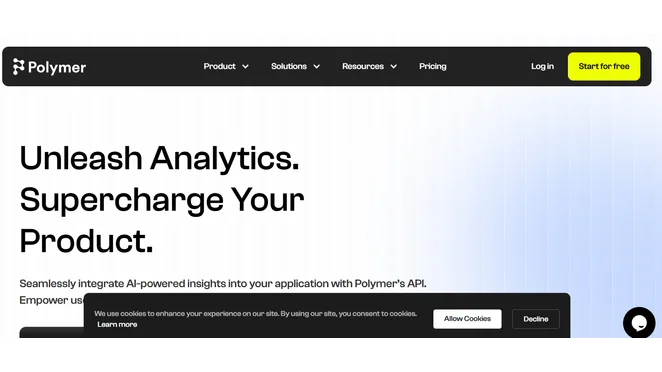
One of the best AI tools for data analysis is Polymer. It is an AI-driven embedded analytics platform that is designed in a way to integrate data visualization and analysis capabilities into various applications.
Furthermore, Polymer enables users to enhance the creation of interactive dashboards and reports without the need to learn advanced technical and programming skills. This platform has made data insights accessible to every organization.
Key Features
Here is the list of key features offered by Polymer:
- Dashboard Creator
- AI-Generated Dashboards
- Embedded Analytics
- Conversational AI
- Integration with Multiple Data Sources
Pros and Cons
Pros
- It helps the user interpret complex data visualizations easily.
- You can seamlessly integrate this platform with existing applications.
- This platform is highly scalable to fit all business needs.
Cons
- New users may find its features overwhelming.
- The advanced features are limited
Pricing
You can start for free or upgrade to paid plans starting from $50/mo.
7. Adobe Analytics
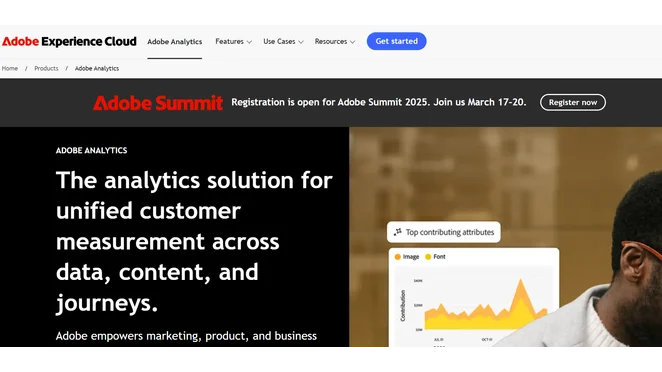
Looking for a comprehensive tool for data analysis tasks? If so, then meet Adobe Analytics. It is a revolutionary platform that helps the user with in-depth insights into customer behavior. Data scientists can use this platform to access and collect real-time data.
Moreover, this platform measures and visualizes creative assets across various channels to help the team make data-driven decisions to improve user retention and streamline product experiences.
Key Features
Let’s dive into the features of Adobe Analytics:
- Customer Journey Analytics
- Web & Mobile Analytics
- Integrations
- Product Analytics
- Content Analytics
Pros and Cons
Pros
- You can gain reports and analytics for given metrics of data.
- Users can build automated reports and schedule them.
- Adobe Analytics can allow you to access real-time alerts.
Cons
- The technical support provided by this platform is limited.
- Pricing plan could be an issue for some users.
Pricing
You can get started for free and upgrade to paid plans by filling out a form available on their website.
8. Akkio
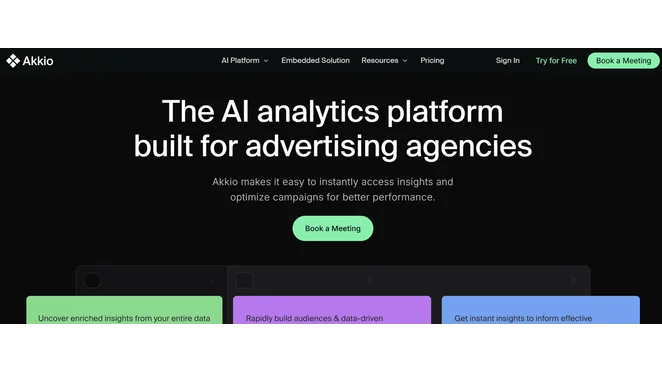
Get ready to access insights instantly with Akkio. This innovative platform is powered by artificial intelligence to improve data analysis. With its revolutionary features, you can analyze unstructured data to make better decisions.
Furthermore, you can save time and improve data preparation. From pitching to optimizing the data, this AI does it all.
Key Features
Akkio offers a range of features listed below:
- Campaign Optimization
- Data Analytics Integrations
- Real-Time Insights
- Reporting
- Ad Targeting
- Non-Coder Usage
- Scalable
Pros and Cons
Pros
- It uses predictive analytics to provide customizable options to businesses.
- You can integrate this into Google BigQuery.
- This platform can handle high volumes of data easily.
Cons
- Akkio can be complex fo rbeginners.
- The pricing plan makes it inaccessible to all users.
Pricing
The amazing thing about Akkio is that it offers a free plan along with paid options starting from $49/month.
9. Qlik Sense
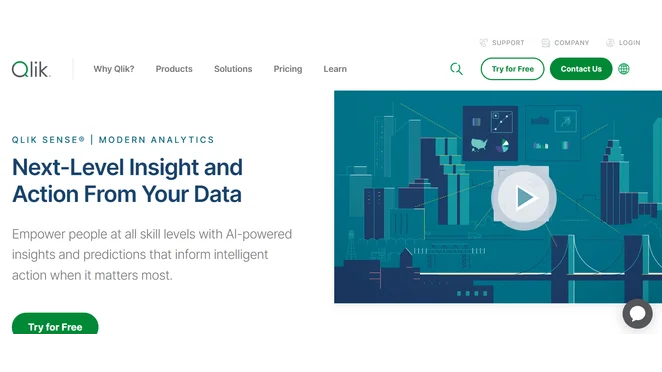
Do you want to explore data freely? If yes, meet Qlik Sense, an AI-powered platform that helps you analyze data by uncovering hidden insights. You can automate data prep by making selections that enhance the clarity and impact.
In addition, the platform offers a variety of visualization options that adapt the intent based on data content. You can also create, edit, and share analytics without the need for extensive coding.
Key Features
Qlik Sense offers the following features:
- Associative Engine
- Smart Visualizations
- Self-Service Creation
- Data Integration
- Collaboration and Sharing
Pros and Cons
Pros
- It has a user-friendly interface that almost anyone can use.
- This platform is capable of handling large volumes of data.
- Qlik Sense can be easily integrated with other tools.
Cons
- Dealing with complex data can be challenging.
- The design flexibility is limited in this platform.
Pricing
You can try it for free or upgrade to paid plans starting from $825/mo.
10. Domo
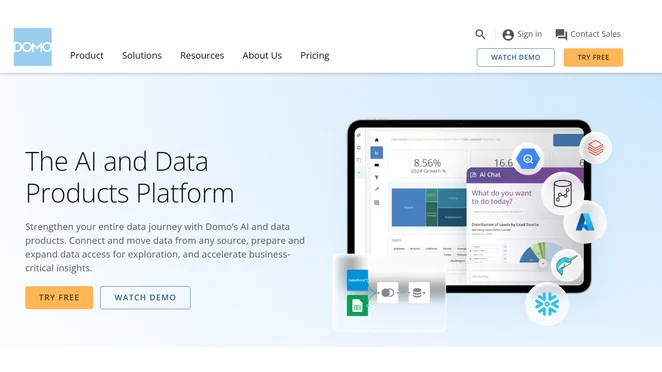
Last but not least, AI tools for data analysis have changed the patterns of how data was organized, analyzed, optimized, and managed previously. One such tool is Domo. It is an AI-powered data analytics that enables organizations to connect, visualize, and analyze data in real time.
Furthermore, there are over 1,000 pre-built data connectors for the ease of users. Domo also offers collaboration tools for ease of use.
Key Features
Some of the incredible features are given below:
- Data Integration
- Data Visualization
- Real-Time Data Updates
- Collaboration Tools
- App Creation
Pros and Cons
Pros
- It provides real time data capabilities to make informed decisions promptly.
- This platform allows you to handle large volumes of data.
- You can connect this platform with a wide range of data connectors.
Cons
- Data export options are limited on this platform.
- The level of customization available for visualizations is limited.
Pricing
Domo can be tried for free, or users can upgrade to paid plans by contacting their sales team.
Benefits of AI Data Analytics
There are various benefits offered by AI tools for data analysis:
- The AI algorithms are fast and accurate and can help in identifying trends and patterns that are missed by the human eye.
- These tools have advanced predictive capacities that use historical data to help the user make informed decisions and gain a competitive edge.
- It lets the user save time by automating repetitive tasks and focusing on more strategic and creative perspectives on your business.
- With these tools, users can uncover hidden correlations between complex datasets.
- You can enhance efficiency and productivity by automating tasks with reduced costs.
Choosing the Right Data Analysis Tools
Choosing the right tools can be challenging, so here are some of the key factors to consider while choosing the tool:
1. Define Your Specific Needs
The first thing you need to do while selecting a tool for data analysis is to check what type of data you’re handling. Is it structured or unstructured, or a mix? After that, you need to check the modeling, i.e., predictive, machine learning, etc. You can also define the skill levels, budget, and scalability of an AI tool based on your preferences.
2. Key Considerations
The next step is key considerations. In this section, you need to find the interface, data connectivity options, visualization, and more features like this. Other than that, you can also check for security and compliance with support and training requirements.
3. Popular Data Analysis Tools
There are various options, and finding the best could be overwhelming. So, you can look for available guides, reviews, and other special requirements you may have.
4. Evaluation Process
The most critical step is evaluating the tool. You can start by testing the capabilities of tools and move towards the payment options it offers. Further, you can read reviews and compare tools with each other.
Conclusion
In conclusion, there are various online tools available on the market, but finding the best one is essential for enhancing the workflows. In this guide, AIChief’s editors have reviewed and added top tools to enhance your data management. These tools can extract data from Google Sheets and various other forms of data to make it accessible.
The best ones of all are IBM Watson Analytics and Qlik Sense. Whether you’re searching for a tool for personal data analysis or for your organization, these tools offer scalable options.
Try these tools today and boost your workflow productivity!
FAQs
Is there any AI tool for data analysis?
Yes, there are various online AI tools available for data analysis, such as Adobe Analytics.
Is there a free AI tool to analyze Excel data?
Yes, like any other AI tool, you can analyze Excel data with AI tools. One such tool is IBM Watson Analytics.
How to use AI in data analysis?
AI tools can be used for a list of tasks, such as:
Data Preparation and Cleaning
Predictive Modeling
Advanced Analytics
Data Visualization and Reporting
Decision Making and Automation
